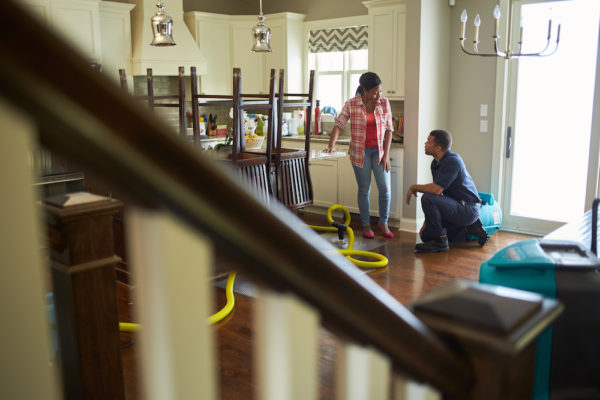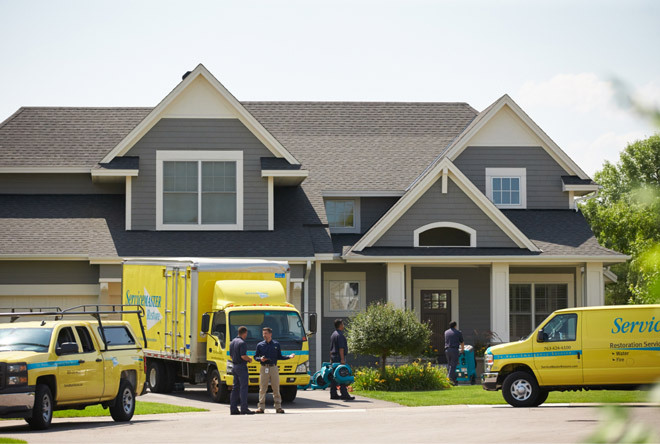Emergency Residential Water Damage Cleanup in Barnegat, NJ
 In a water damage scenario, water typically spreads out and flows through
the path of least resistance, especially toward substructures and lower
floors. Porous materials, whether wood, sheetrock or other building materials,
will soak up the water, which can even travel upward. The resulting effects
can include discoloration, swelling, broken adhesive bonds, delamination
(flooring separation), warping and overall breakdown of building materials
that make up your property. The more time that elapses before treatment,
the greater the damage. Even if the water evaporates unassisted, it can
cause damage to ceilings, walls and contents.
In a water damage scenario, water typically spreads out and flows through
the path of least resistance, especially toward substructures and lower
floors. Porous materials, whether wood, sheetrock or other building materials,
will soak up the water, which can even travel upward. The resulting effects
can include discoloration, swelling, broken adhesive bonds, delamination
(flooring separation), warping and overall breakdown of building materials
that make up your property. The more time that elapses before treatment,
the greater the damage. Even if the water evaporates unassisted, it can
cause damage to ceilings, walls and contents.
ServiceMaster Clean is a highly reputable company in Ocean County and is a licensed, insured and endorsed water damage service provider. In addition to our years of experience with water damage, our qualified technicians have completed advanced training in water damage mitigation, dehumidification systems, mold remediation and corrosion control. They also seek continuing education to learn about new techniques and equipment to better serve you in your time of need.
The information in this literature is general in nature and may not apply to your specific needs. However, we hope it will help answer your questions and aid you in understanding the process and procedures in restoring your property after a water damage
Understanding The Drying Process
It is our goal to restore your property as quickly and efficiently as possible. The drying and restoration may require up to three phases before completion.
PHASE 1: Emergency Service
Upon arrival to a water damage, a Statement of Authorization will need to be signed before work can begin. A ServiceMaster Clean trained technician will begin by determining if your carpet is salvageable and if the carpet can be dried in place. If so, we will extract as much water as possible. High-velocity air movers and dehumidifiers will be set to dry the carpet and sub-floor quickly. Equipment must be left on for the designated amount of time to ensure proper drying. The carpet may need to be treated to inhibit microbial growth. If the pad cannot be dried in place, we will detach the carpet from the tack strip and remove the wet padding to expedite the drying process. A pad sample will be taken back to our office to be matched and ordered for the reinstallation. If your carpet is deemed unsalvageable, the technician may advise removing both the pad and carpet.
Job Site Inspections
It will be necessary for us to have access to your property during business hours throughout the drying process in order to properly monitor the temperature, humidity and our equipment. Please work with our office on your preferred method for re-entry to your property so we can properly monitor the drying process.
PHASE 2: Reinstallation/Cleaning
When carpet can be successfully restored, we may need to install new pad and reinstall the carpet. Reinstallation includes restretching, reattaching the tack strip, seam repair and threshold repair and /or replacement. After the reinstallation, carpet is cleaned and deodorized. When the carpet and pad can be successfully restored through in-place drying, the carpet will still need to be cleaned and deodorized. During this phase, any upholstery or other damaged furnishings will be cleaned. If equipment is still present, the technician will remove it at this time.
PHASE 3: Structural Repairs
If applicable, after the drying process is complete, structural damage is assessed and the repair phase can begin. At this time, drywall, ceilings and floors will be repaired. If carpet cannot be salvaged, new carpet and pad will be installed. It may be appropriate to complete structural repairs before reinstallation and cleaning.


